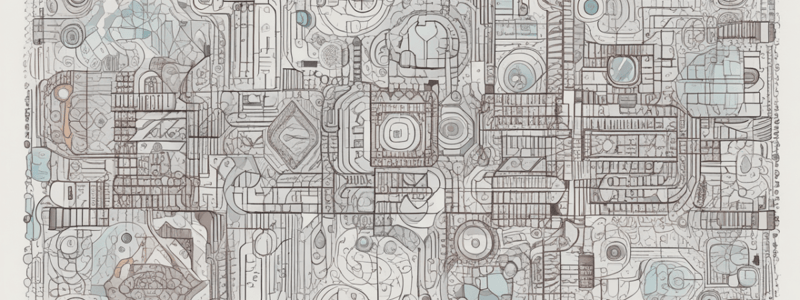Podcast
Questions and Answers
What is a major drawback of using a giant constructor with all possible parameters in the base House class?
What is a major drawback of using a giant constructor with all possible parameters in the base House class?
- It eliminates the need for subclasses.
- It makes the constructor calls pretty ugly with unused parameters. (correct)
- It reduces the complexity of the House class.
- It increases the performance of the House object.
What is the main advantage of using the Builder pattern to construct complex objects?
What is the main advantage of using the Builder pattern to construct complex objects?
- It allows other objects to access the product while it's being built.
- It enables the construction of complex objects step by step. (correct)
- It reduces the number of subclasses needed.
- It improves the performance of the object construction process.
What is a potential consequence of creating a subclass for every possible configuration of an object?
What is a potential consequence of creating a subclass for every possible configuration of an object?
- The number of parameters in the constructor decreases.
- The program becomes too simple.
- The program becomes too complex with many subclasses. (correct)
- The object construction process becomes faster.
What is the purpose of the Builder objects in the Builder pattern?
What is the purpose of the Builder objects in the Builder pattern?
What is a potential issue with using a monstrous constructor with lots of parameters?
What is a potential issue with using a monstrous constructor with lots of parameters?
What is a major difference between the Builder pattern and the Abstract Factory pattern?
What is a major difference between the Builder pattern and the Abstract Factory pattern?
What is the main benefit of using the Builder pattern instead of a giant constructor with all possible parameters?
What is the main benefit of using the Builder pattern instead of a giant constructor with all possible parameters?
What is a key characteristic of the Builder pattern?
What is a key characteristic of the Builder pattern?
What is the primary purpose of the Builder pattern?
What is the primary purpose of the Builder pattern?
What is the main difference between the Builder pattern and the Abstract Factory pattern?
What is the main difference between the Builder pattern and the Abstract Factory pattern?
What is the role of the director in the Builder pattern?
What is the role of the director in the Builder pattern?
Why is it beneficial to use a director class in the Builder pattern?
Why is it beneficial to use a director class in the Builder pattern?
What is the advantage of using multiple builder classes in the Builder pattern?
What is the advantage of using multiple builder classes in the Builder pattern?
How does the Builder pattern improve code reuse?
How does the Builder pattern improve code reuse?
What is the relationship between the builder and the director in the Builder pattern?
What is the relationship between the builder and the director in the Builder pattern?
When would you use the Builder pattern?
When would you use the Builder pattern?
What is the main benefit of separating the construction process from the representation of the product?
What is the main benefit of separating the construction process from the representation of the product?
How does the Builder pattern decouple the construction process from the client code?
How does the Builder pattern decouple the construction process from the client code?
What is the primary purpose of the Director class in the Builder pattern?
What is the primary purpose of the Director class in the Builder pattern?
In the Builder pattern, which class is responsible for creating the final product?
In the Builder pattern, which class is responsible for creating the final product?
What is the key difference between the Factory Method pattern and the Abstract Factory pattern?
What is the key difference between the Factory Method pattern and the Abstract Factory pattern?
In the Builder pattern, why is the Director class not dependent on the concrete builder classes?
In the Builder pattern, why is the Director class not dependent on the concrete builder classes?
What is the benefit of using the Builder pattern over the Factory Method pattern?
What is the benefit of using the Builder pattern over the Factory Method pattern?
In the Builder pattern, which class is responsible for initiating the construction process?
In the Builder pattern, which class is responsible for initiating the construction process?
Which creational pattern is used when the products are quite complex and require extensive configuration?
Which creational pattern is used when the products are quite complex and require extensive configuration?
What is the main purpose of the director class in the Builder pattern?
What is the main purpose of the director class in the Builder pattern?
Which of the following statements is true about the Builder pattern?
Which of the following statements is true about the Builder pattern?
What is the role of the concrete builder classes in the Builder pattern?
What is the role of the concrete builder classes in the Builder pattern?
Why can't the getProduct method be declared in the builder interface?
Why can't the getProduct method be declared in the builder interface?
What is the purpose of the reset method in the concrete builder class?
What is the purpose of the reset method in the concrete builder class?
Which of the following is a characteristic of the Builder pattern?
Which of the following is a characteristic of the Builder pattern?
What is the relationship between the Car and Manual classes?
What is the relationship between the Car and Manual classes?
What is the benefit of using the Builder pattern?
What is the benefit of using the Builder pattern?
Why is the Builder pattern different from other creational patterns?
Why is the Builder pattern different from other creational patterns?
Flashcards are hidden until you start studying
Study Notes
The Problem of Complex Object Initialization
- Complex objects require laborious, step-by-step initialization of many fields and nested objects.
- Initialization code is usually buried inside a monstrous constructor with lots of parameters or scattered all over the client code.
- Creating a subclass for every possible configuration of an object can lead to a large number of subclasses, making the program too complex.
The Builder Pattern
- The Builder pattern suggests extracting the object construction code out of its own class and moving it to separate objects called builders.
- The Builder pattern lets you construct complex objects step by step.
- The Builder doesn't allow other objects to access the product while it's being built.
- The pattern organizes object construction into a set of steps (e.g., buildWalls, buildDoor, etc.).
Benefits of the Builder Pattern
- You don't need to call all the steps; you can call only those steps that are necessary for producing a particular configuration of an object.
- Different builders can execute the same task in various ways, allowing for different representations of the product.
- The Builder pattern makes sense only when your products are quite complex and require extensive configuration.
The Director
- The Director class defines the order in which to execute the building steps, while the Builder provides the implementation for those steps.
- The Director knows which building steps to execute to get a working product.
- Having a Director class in your program isn't strictly necessary; you can always call the building steps in a specific order directly from the client code.
- The Director class might be a good place to put various construction routines so you can reuse them across your program.
Pseudocode Example
- The example illustrates how you can reuse the same object construction code when building different types of products, such as cars, and create the corresponding manuals for them.
- The CarBuilder class has a set of methods for configuring various parts of a car, and the ManualBuilder class implements the same building methods but describes the car features instead of crafting car parts.
- By passing these builders to the same Director object, you can construct either a car or a manual.
Studying That Suits You
Use AI to generate personalized quizzes and flashcards to suit your learning preferences.




